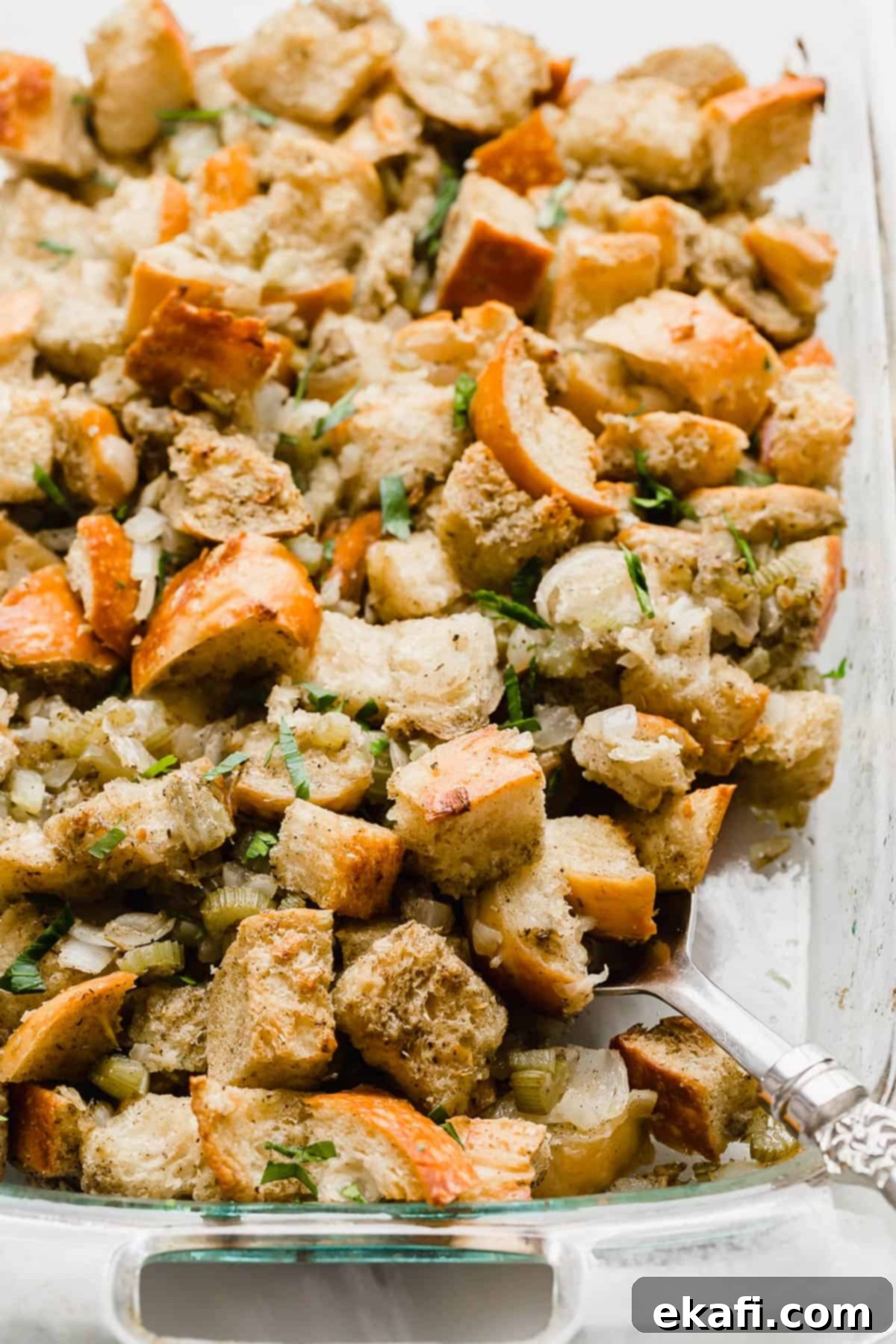Classic Thanksgiving Stuffing Recipe: Your Ultimate Guide to a Flavorful, Moist Holiday Side
Prepare to elevate your holiday feast with this classic, foolproof Thanksgiving stuffing recipe. Renowned for its irresistibly buttery flavor and perfectly moist texture, this dish isn’t just a side; it’s a Thanksgiving dinner essential and a beloved fall recipe that promises to steal the show. Forget bland or dry stuffing; this recipe is crafted to deliver an unforgettable experience every single time.
Thanksgiving dinner often represents the year’s most significant culinary endeavor, and having a repertoire of tried-and-true recipes is key to a stress-free and undeniably delicious celebration. My Thanksgiving table is always graced with these cherished favorites: Easy Sweet Potato Casserole, the Best Dinner Rolls, Creamy Homemade Mashed Potatoes, Bacon Green Bean Casserole, and a decadent Praline Pumpkin Pie. And, of course, this incredible stuffing perfectly complements them all.
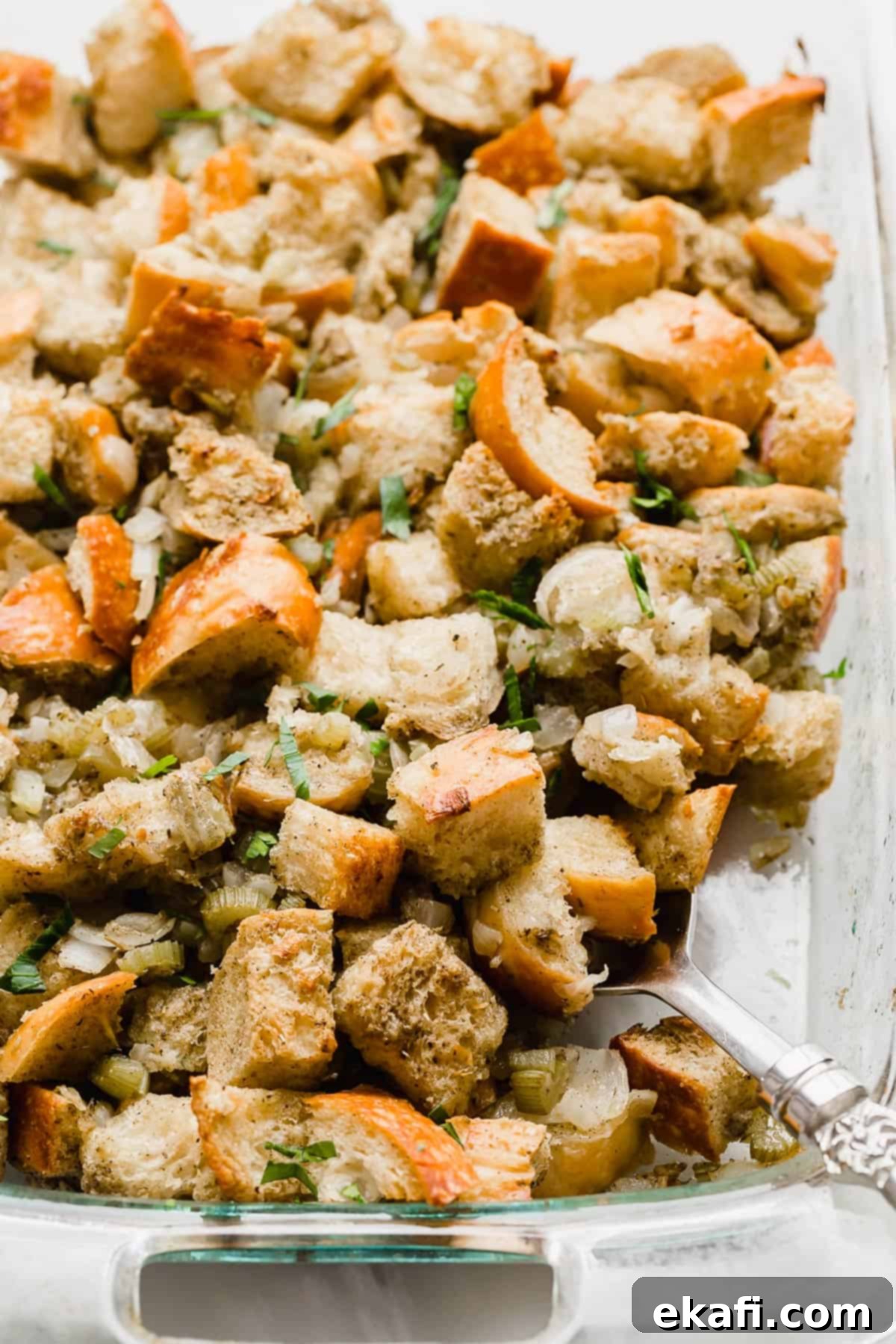
Why This Thanksgiving Stuffing Recipe is a Must-Try
This isn’t just any stuffing recipe; it’s a carefully crafted method designed to deliver exceptional results every time. Here’s why this particular recipe stands out and deserves a permanent spot on your holiday menu:
- Unbeatable Texture and Flavor Harmony. I consistently prioritize both incredible flavor and perfect texture in my recipes, and this Thanksgiving stuffing delivers on both fronts! The choice of French bread is absolutely critical, as its robust structure ensures the stuffing remains delightfully textured rather than turning into a soggy mess. Coupled with a masterfully balanced blend of seasonings, every bite offers a burst of savory goodness that is truly next level. The interplay of soft bread, tender vegetables, and aromatic spices creates a symphony for your palate.
- Bid Farewell to Bland Stuffing Forever. The ultimate secret to unlocking truly profound flavor in your stuffing lies in three core components: quality butter, a thoughtful selection of seasonings, and rich chicken stock. These elements work in harmony to transform what can often be a monotonous side dish into the star of the meal. Trust me, once you try this recipe, you’ll never settle for lackluster stuffing again. It’s so good, it might just become your favorite Thanksgiving dish!
- The Ideal Balance of Bread and Savory Vegetables. I adore traditional stuffing, and in my opinion, the classic combination of perfectly cubed bread, finely chopped celery, and aromatic onion achieves an unrivaled balance. This foundational trio offers a comforting and familiar flavor profile that many crave during the holidays. However, there are times when a little more variety is desired! If you’re looking to explore a stuffing recipe with an expanded array of vegetables or the hearty addition of sausage, I highly recommend exploring my Autumn Vegetable Stuffing Recipe for delicious variations.
Key Ingredients for the Perfect Stuffing
Crafting phenomenal Thanksgiving stuffing starts with selecting the right ingredients. Each component plays a vital role in achieving that coveted buttery flavor and moist, yet structured, texture. Here’s a closer look at what you’ll need and why it matters:
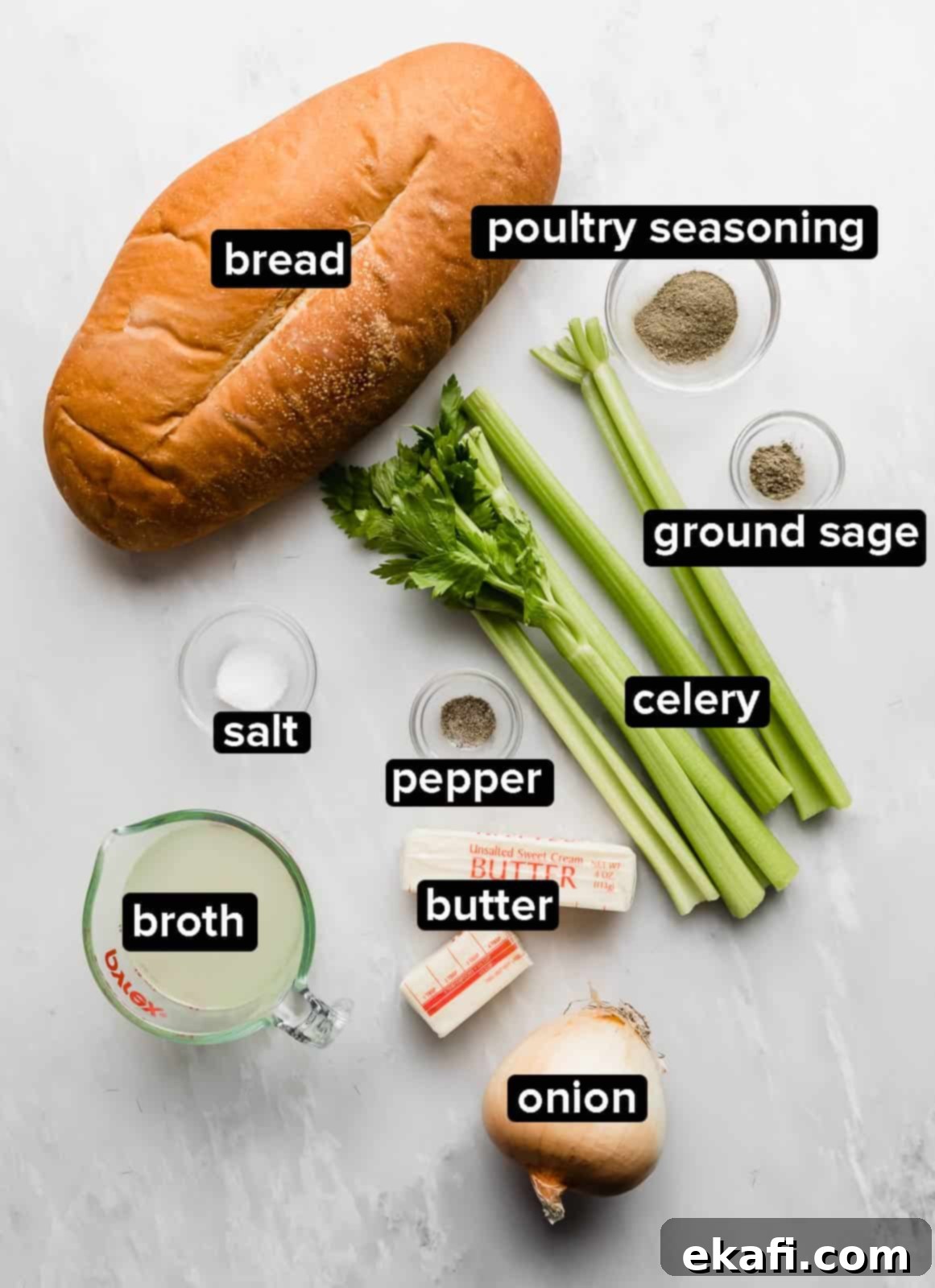
- French Bread Loaf: This is arguably the most critical ingredient. Using a day-old French bread loaf makes an enormous difference. Its sturdy crust and airy interior allow it to absorb moisture without disintegrating, ensuring your stuffing maintains some structural integrity and avoids becoming mushy. This creates a delightful contrast in textures in every spoonful.
- Fresh Vegetables: Finely chopped celery and onion are the aromatic foundation of this stuffing. They don’t just add great texture; they release incredible savory flavors as they sauté, forming the essential base for all the other seasonings to build upon.
- Poultry Seasoning: This classic spice blend is a staple in most traditional stuffing recipes for a reason. It typically comprises marjoram, thyme, rosemary, and sage – a fragrant mix that imparts that quintessential, comforting holiday taste that defines Thanksgiving.
- Chicken Broth: Opting for chicken broth instead of plain water is absolutely essential for flavor depth. The savory notes from the broth infuse deeply into the bread, creating a richer, more complex stuffing that simply cannot be achieved with water alone. It’s the liquid gold that binds and flavors.
- Unsalted Butter: Butter is the secret weapon for both flavor and an incredible mouthfeel. Adding a generous amount of butter enriches the entire dish, creating a luxurious depth of flavor. It also contributes significantly to the divine, moist, and tender texture of the stuffing, ensuring it’s never dry.
Easy Step-by-Step Instructions for Classic Thanksgiving Stuffing
Follow these simple steps to create a truly spectacular stuffing that will impress everyone at your holiday table. Precision in preparation ensures the perfect balance of flavor and texture.
- Prepare the Bread with Care. Begin by cutting your French bread loaf into uniform 1-inch cubes. The consistency of the cubes is important for even drying and absorption. Once cut, spread them out in a single layer on a large baking sheet and allow them to air dry overnight. This crucial step prevents your stuffing from becoming overly mushy. (For an alternative quick-drying method, see our “Recipe Tips” section below.)
- Sauté the Aromatics to Perfection. In a spacious Dutch oven or a large, heavy-bottomed pot, melt the butter over medium heat. Once it’s shimmering, add the chopped onion and celery. Cook these aromatic vegetables, stirring occasionally, until they become soft and translucent, which typically takes about 6-8 minutes. As they soften, season generously with poultry seasoning, ground sage, salt, and black pepper. The fragrance alone will start to build your excitement!
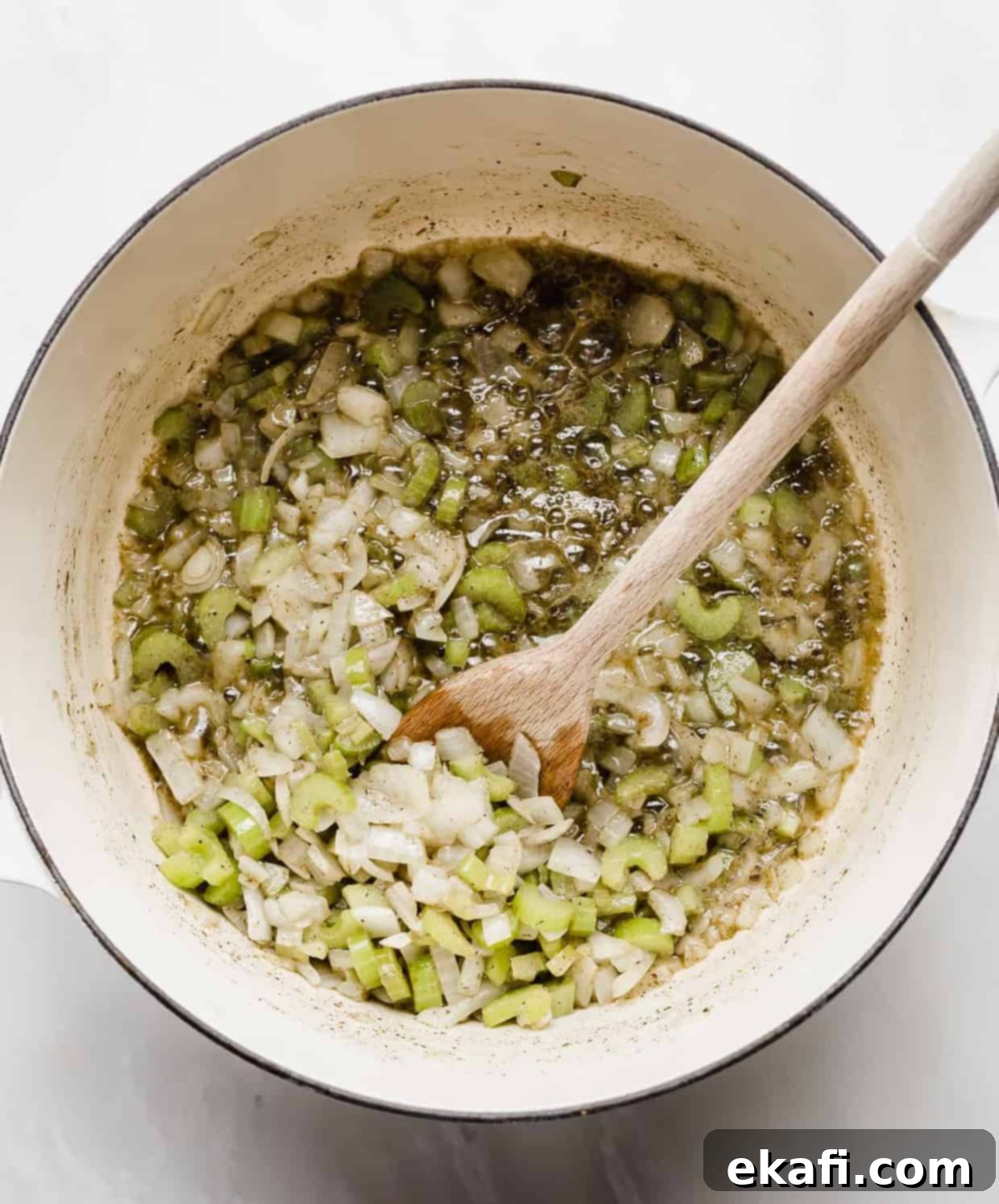
- Incorporate the Dried Bread. Add the thoroughly dried-out cubed bread to the Dutch oven with the sautéed vegetables. Stir everything together gently but thoroughly until all the bread cubes are evenly coated with the seasoned butter and aromatics. This ensures every piece of bread is infused with flavor before adding the liquid.
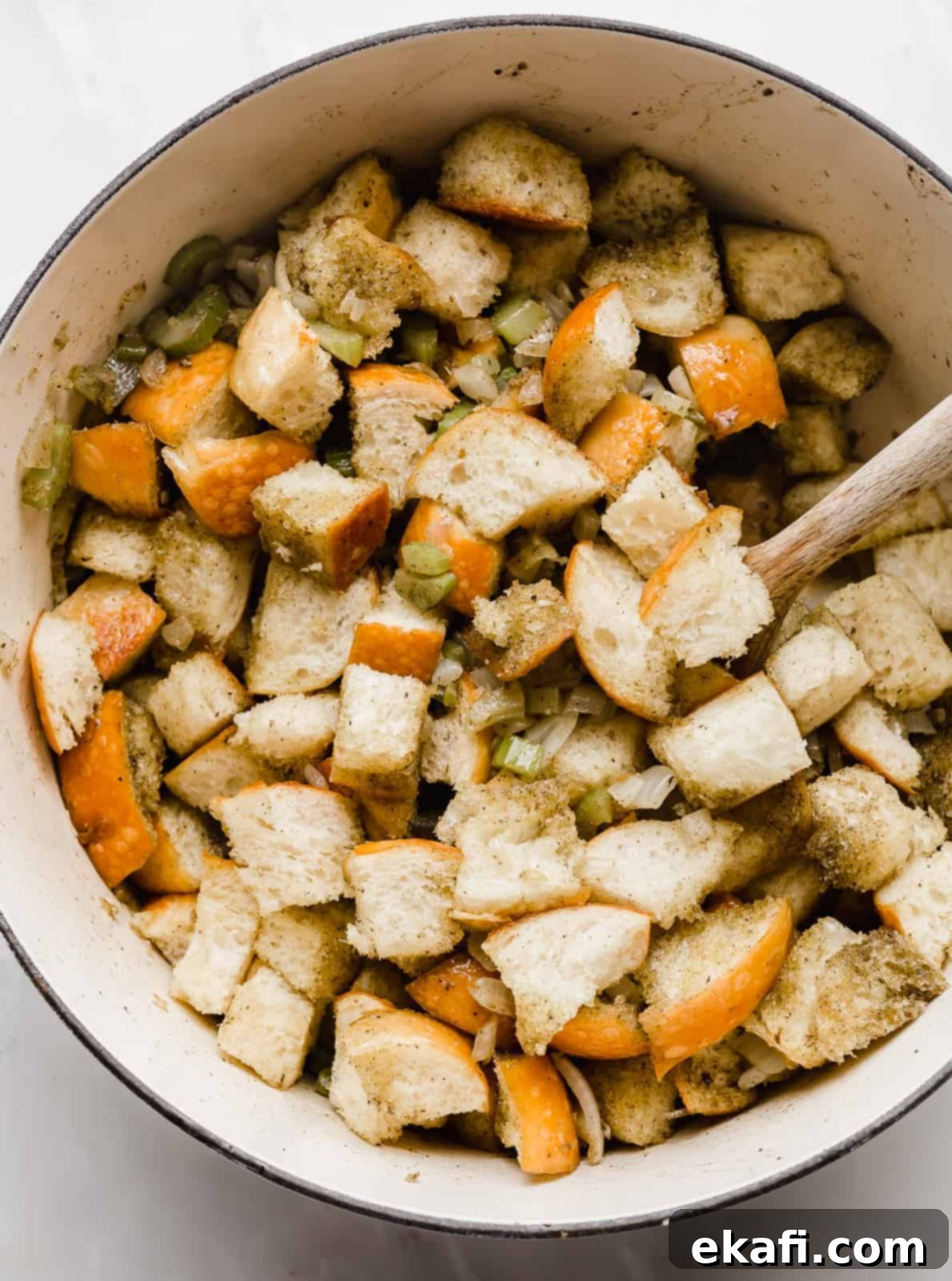
- Gradually Stir in the Broth. This is a crucial step for achieving the perfect moist, not soggy, texture. Begin to add the chicken broth, a little at a time (this means SLOWLY!), while continuously mixing the stuffing. The goal is for the bread to absorb the liquid evenly without becoming overly saturated. Mix well until all ingredients are combined and the bread has achieved a desirable level of moistness. You might not need all the broth, so trust your judgment here.
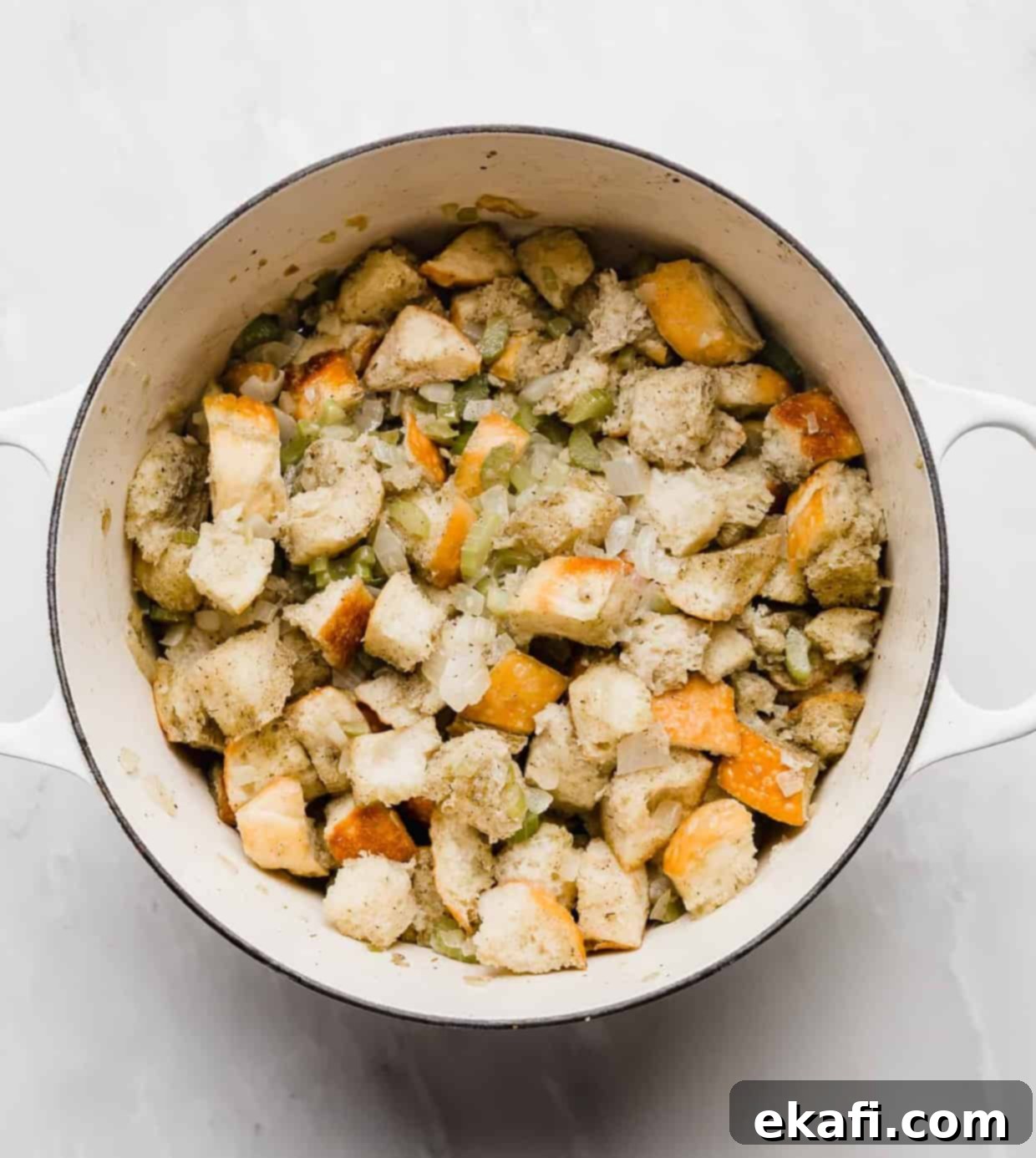
- Transfer and Chill for Flavor Development. Lightly butter a 9×13-inch casserole dish to prevent sticking and add another layer of flavor. Transfer the prepared stuffing mixture into the buttered dish, spreading it evenly. Cover the dish tightly with plastic wrap and chill it in the refrigerator until you are ready to bake. This can be done several hours in advance – I often chill mine for 4-6 hours, and the flavors develop beautifully.
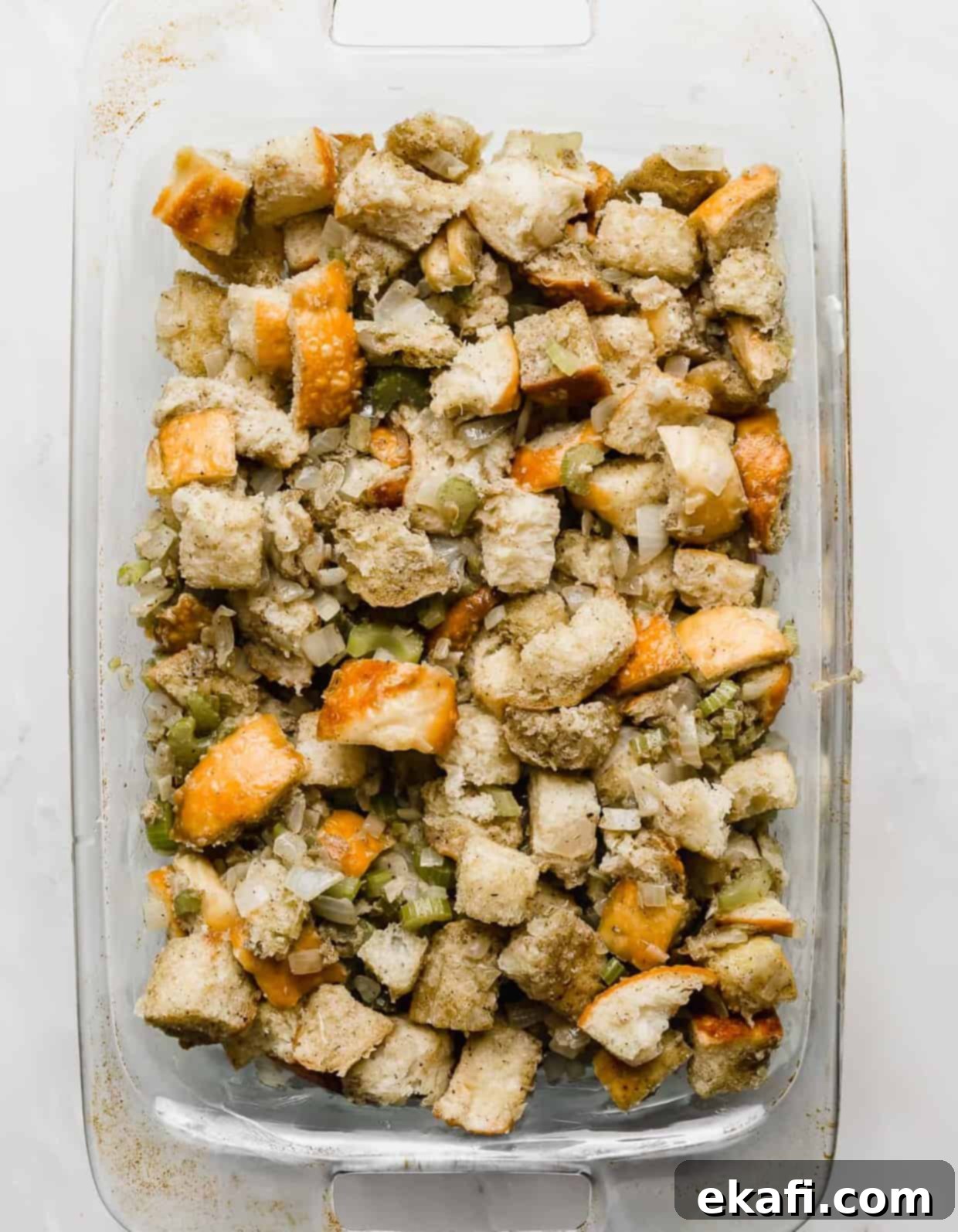
- Bake to Golden Brown Perfection. Preheat your oven to 350°F (175°C). Place the uncovered casserole dish into the preheated oven and bake for 30-40 minutes. You’ll know it’s ready when the top of the stuffing achieves a beautiful, inviting golden-brown crust and the edges are slightly crisp. Carefully remove it from the oven and serve warm, allowing its fragrant steam to tantalize your guests.
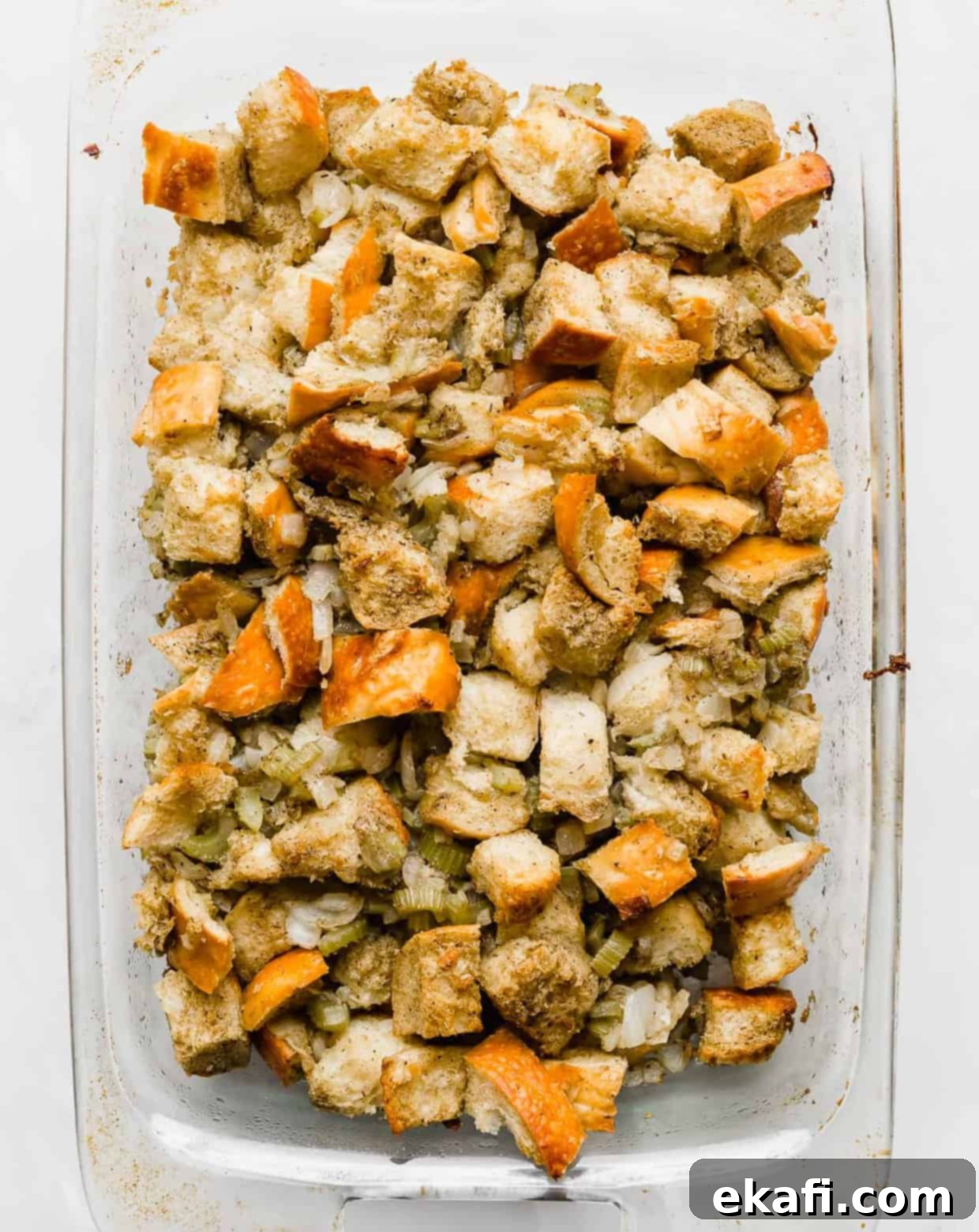
Expert Tips for the Best Thanksgiving Stuffing
Enhance your stuffing experience with these helpful tips, designed to ensure perfect results and offer delicious variations.
- Achieving Moist Stuffing. If you prefer your stuffing to be extra moist and tender throughout, bake it covered with aluminum foil for the first 15 minutes. This traps steam and moisture, preventing the top from drying out too quickly. After this initial period, remove the foil and continue baking uncovered for the remaining 20-30 minutes to allow the top to crisp up and achieve that beautiful golden-brown finish.
- Adding Savory Sausage. For a heartier stuffing with an added layer of rich flavor, consider incorporating cooked sausage. You can use either 8 oz or 16 oz (depending on your preference for meatiness) of plain breakfast sausage or, for an extra aromatic kick, try sage sausage. Cook the sausage thoroughly, drain any excess fat, and then stir it into the stuffing mixture along with the dried bread.
- The Importance of Thoroughly Dried Bread. Do not skip the step of drying out the bread overnight! This is absolutely critical for the stuffing’s texture. If your bread isn’t sufficiently dry, it will absorb too much liquid and result in an overly mushy, unappetizing stuffing. For a quicker method, you can cube the bread, spread it on a baking sheet, and bake it in a 350°F (175°C) oven for about 10-15 minutes, or until lightly toasted and dried.
- Creative Uses for Leftover Stuffing. Don’t let a single bite of this delicious stuffing go to waste! Leftovers are fantastic served alongside leftover turkey salad sandwiches for a taste of Thanksgiving comfort. For dessert, of course, nothing beats a slice of delicious Thanksgiving pie. Get creative and try making stuffing waffles, stuffing patties, or even adding it to a frittata for a next-day brunch.
Frequently Asked Questions About Thanksgiving Stuffing
Got questions about making the perfect Thanksgiving stuffing? We’ve got answers to help you navigate common queries and ensure your dish is a success.
Yes, absolutely. For both food safety and optimal texture, any meat you plan to add to your stuffing, such as sausage or ground beef, must be fully cooked and drained of excess fat before you stir it into the remaining ingredients. Adding raw or undercooked meat can introduce harmful bacteria and affect the final texture of your stuffing.
While the terms are often used interchangeably, particularly across different regions, there’s a subtle distinction for some. Traditionally, “stuffing” refers to the mixture cooked inside the cavity of the turkey, which helps to impart flavor to the bird from the inside out. “Dressing,” on the other hand, is the same mixture but cooked separately in a casserole dish outside the turkey. In practice, however, most people now use “stuffing” to refer to the dish regardless of where it’s cooked, especially given food safety recommendations against cooking it inside the bird (as discussed below).
I generally do not recommend using this recipe to stuff your turkey without significant alterations and strict adherence to food safety guidelines. Stuffing a turkey presents a food safety challenge: for the stuffing to be safe to eat, it must reach an internal temperature of 165°F (74°C). Achieving this temperature in the stuffing often means the turkey itself becomes overcooked and dry, as the breast meat typically cooks faster. Furthermore, stuffing touches raw poultry, requiring it to cook thoroughly to eliminate bacteria. For these reasons, baking your stuffing separately in a casserole dish is usually the safest and best way to ensure both delicious stuffing and a perfectly cooked turkey.
Some stuffing recipes include eggs, which act as a binder to help hold the stuffing together. In this classic recipe, however, I choose to omit eggs. I find them unnecessary for achieving the desired consistency and, in some cases, they can alter the texture of the stuffing, making it denser or more like a bread pudding. My goal is a light, yet moist, stuffing that allows the bread and vegetable textures to shine through, which is why I prefer to leave them out.
For this recipe, I absolutely love using a French bread loaf. Its robust crust and open crumb structure are ideal because they allow the bread to dry out thoroughly without becoming brittle, and it absorbs liquid beautifully without turning to mush. The tougher crust also adds a fantastic textural element to the final dish. Other excellent choices include sourdough, challah, or even a good quality sandwich bread, but always ensure it’s day-old and thoroughly dried for the best results.
Yes, stuffing freezes wonderfully, making it a great make-ahead option or a way to enjoy leftovers later! After baking, allow the stuffing to cool completely to room temperature. Then, transfer it to an airtight container or a heavy-duty freezer bag. It can be stored in the freezer for 1-2 months. When you’re ready to enjoy it, remove it directly from the freezer and place it in a preheated 350°F (175°C) oven until it’s warmed through. Thawing it first can sometimes lead to a mushier texture, so baking from frozen is often best to maintain its integrity.
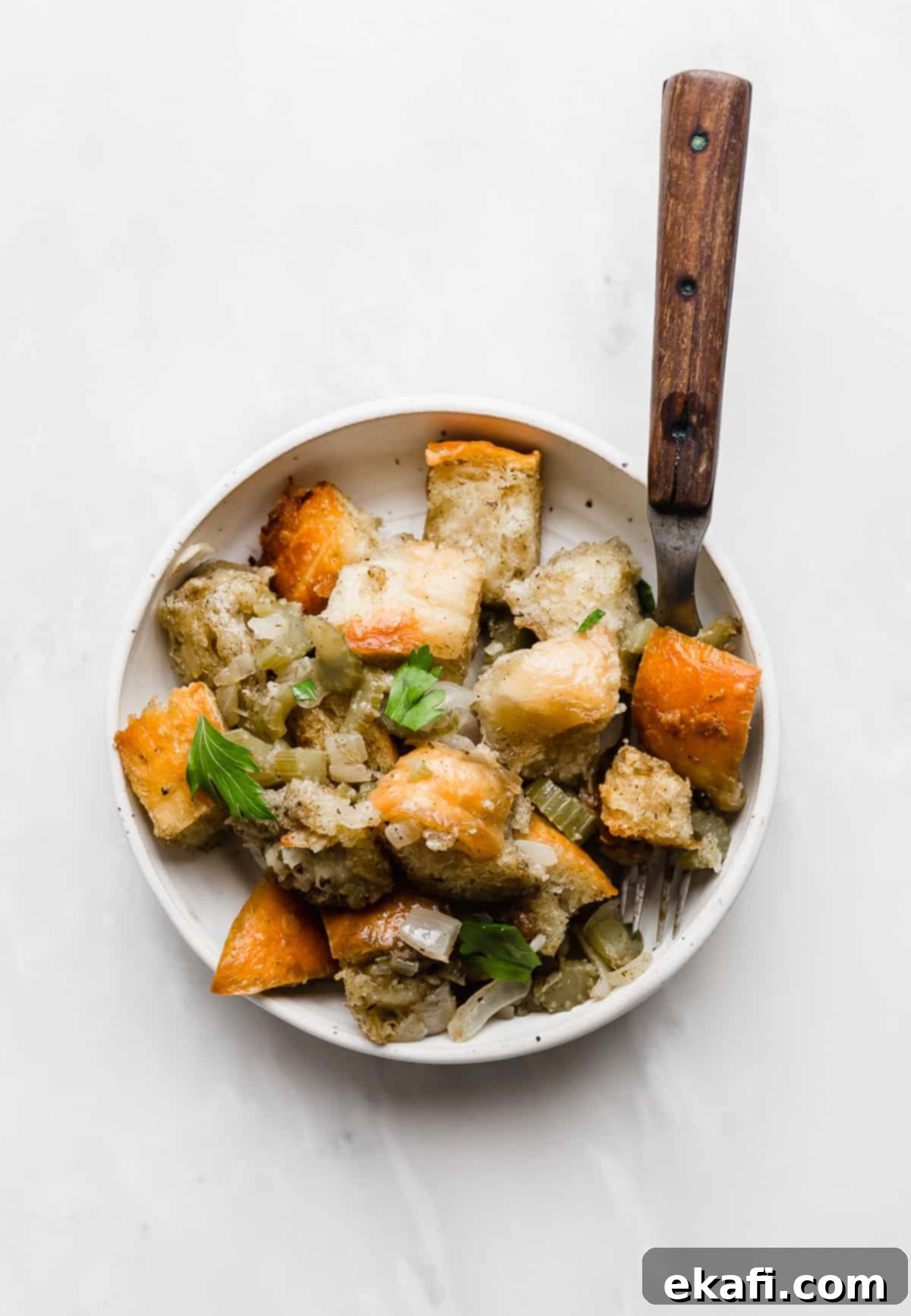
More Must-Try Thanksgiving Recipes
Complete your holiday spread with these other delectable Thanksgiving dishes that pair perfectly with our classic stuffing:
- Sweet and Velvety Candied Yams
- Festive Pomegranate Jell-O Salad
- Delightful Mini No-Bake Pumpkin Cheesecakes
Did you savor every bite of this recipe? I’d absolutely love to hear your thoughts and experiences! Click here to leave a rating and review, or simply scroll down below the recipe card to share your feedback. Your insights help others discover and enjoy this delicious stuffing too!
Stay connected and up-to-date with our latest culinary creations by following us on Instagram, Facebook, and Pinterest.
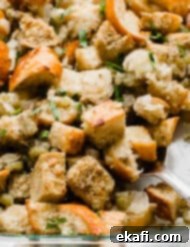
Print
SaveSaved!
Review
Classic Thanksgiving Stuffing Recipe
Ingredients
- 1 large French bread loaf – approximately 1 pound, day-old for best results.
- ¾ cup unsalted butter – for rich flavor and sautéing.
- 1 large yellow onion – finely chopped for aromatic depth.
- 5 stalks celery – chopped, for texture and fresh flavor.
- 3 teaspoons poultry seasoning – the classic holiday spice blend.
- ½ teaspoon ground sage – enhances the savory, earthy notes.
- 1 teaspoon salt – to bring out all the flavors.
- ½ teaspoon black pepper – freshly ground for best aroma.
- 1 cup chicken broth – use good quality broth, see notes for alternative.
Equipment
-
Large Dutch Oven or Heavy-Bottomed Pot
-
Cutting Board and Sharp Knife
-
13″x9″ Glass Baking Pan (Casserole Dish)
Instructions
-
Cut the French bread loaf into uniform 1-inch cubes. Spread them in a single layer on a large baking sheet and leave them uncovered to air dry overnight. This vital step is key to preventing soggy stuffing. Alternatively, if you’re short on time, you can place the cubed bread on a baking sheet and bake it in a 350°F (175°C) oven for about 10-15 minutes, or until the cubes are lightly golden and thoroughly dried out.
-
In a large Dutch oven or heavy pot, melt the butter over medium heat until it’s fragrant and shimmering. Add the chopped onion and celery, stirring frequently, and cook until they are tender and translucent, approximately 6-8 minutes. Season these aromatics generously with poultry seasoning, ground sage, salt, and freshly ground black pepper, allowing the flavors to meld.
-
Add the dried-out cubed bread to the Dutch oven. Gently stir and toss the bread with the sautéed vegetables and seasoned butter until every cube is thoroughly and evenly coated. This ensures maximum flavor absorption.
-
Now, slowly and gradually stir in the chicken broth while continuously mixing the stuffing. The key here is to add the liquid incrementally, allowing the bread to absorb it without becoming overly wet or soggy. Mix well until the entire mixture is uniformly moistened. You may not need the full cup, so stop once the desired moistness is achieved.
-
Transfer the prepared stuffing mixture into a buttered 13×9-inch casserole dish, spreading it out evenly. Cover the dish tightly with plastic wrap and chill it in the refrigerator until you are ready to bake. Chilling for 4-6 hours (or even overnight) allows the flavors to deepen beautifully and makes Thanksgiving morning less hectic.
-
Preheat your oven to 350°F (175°C). Remove the plastic wrap and bake the stuffing uncovered for 30-40 minutes. The stuffing is perfectly cooked when its top is beautifully golden brown and the edges are slightly crispy. Remove it from the oven and serve warm, enjoying its rich, comforting aroma.
Notes
If you desire an extra moist stuffing, cover the baking dish with aluminum foil for the initial 15 minutes of baking. Then, remove the foil and continue baking uncovered for the remaining 20-25 minutes to achieve a lovely golden crust.
Nutrition
This recipe was originally published on November 6, 2020. It was republished and updated on November 1, 2021, to include additional information, improved photos, and enhanced readability for a better user experience.
